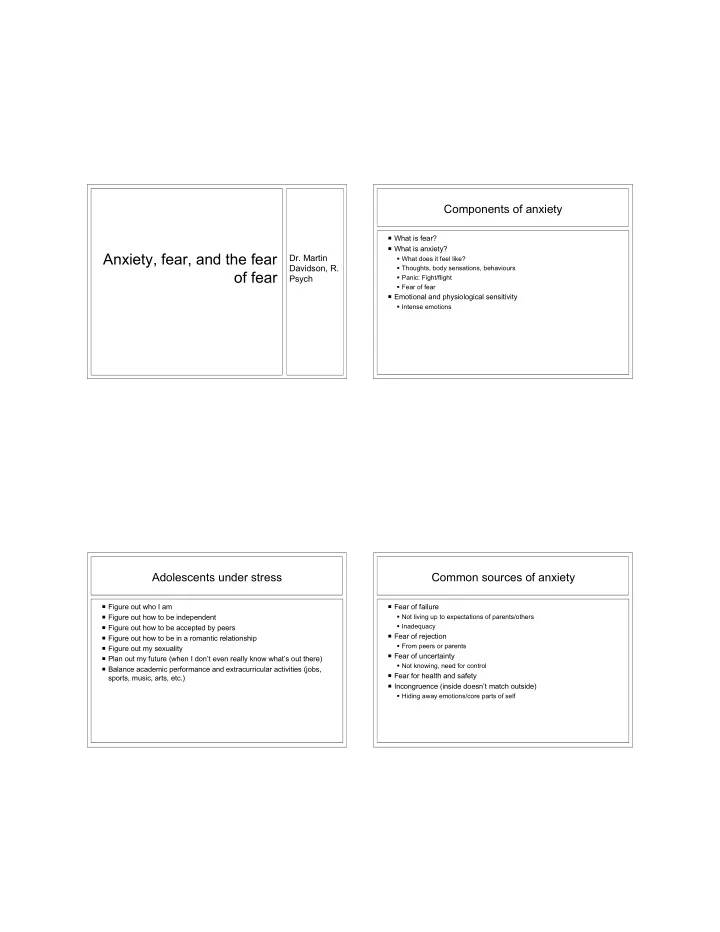

Components of anxiety What is fear? What is anxiety? Anxiety, fear, and the fear Dr. Martin What does it feel like? Davidson, R. Thoughts, body sensations, behaviours of fear Psych Panic: Fight/flight Fear of fear Emotional and physiological sensitivity Intense emotions Adolescents under stress Common sources of anxiety Figure out who I am Fear of failure Figure out how to be independent Not living up to expectations of parents/others Inadequacy Figure out how to be accepted by peers Fear of rejection Figure out how to be in a romantic relationship From peers or parents Figure out my sexuality Fear of uncertainty Plan out my future (when I don’t even really know what’s out there) Not knowing, need for control Balance academic performance and extracurricular activities (jobs, Fear for health and safety sports, music, arts, etc.) Incongruence (inside doesn’t match outside) Hiding away emotions/core parts of self
What can anxiety look like in adolescents? Typical anxiety and fear Anger, outbursts, acting out How to Help – Step 1: Defiance Distancing physically or emotionally from parents Remember how you School avoidance Sleep problems wanted to be treated by Difficulties focusing/concentrating Fatigue parents/adults Physical problems Stomach aches, headaches, pain, dizziness, nausea What to do Be the anchor Be aware of your own anxiety and how it may be affecting your teen The importance of strong attachment relationships “Living” is the enemy of anxiety Understand what’s going on under the surface Anxiety primarily exists in the past and future Combination of getting information from your teen and imagining their perspective Find the sweet spot between pushing too much and not pushing at all Quiet confidence Don’t talk too much leading into anxiety provoking situations Let your kids be anxious. It won’t hurt. Experiencing anxiety and tolerating it is very important Be anxious but face the situation anyways Promote acceptance of anxiety Avoids the battle/struggle against anxiety The more you struggle, the worse it gets
What not to do Concerning behaviours Do not be an accomplice in avoiding fear/anxiety Breaking objects and punching walls Completely normal and safe to be afraid/anxious Getting violent/aggressive The feeling isn’t the problem, it’s what you do with the feeling that can be Escaping to video games problematic Drug and alcohol use Do not try to make it go away Others? Do not convey the message that “it’s all in your head” It isn’t! Do not dismiss as something to get over “You don’t need to be afraid” Be careful of messages associated with “emotion regulation” Addressing Concerning Behaviours Attempting to understand is key Minimizes defensiveness Increases ability to explore negative aspects of behaviour Uncovers what your teen is getting out of this behaviour (must be gaining something) Openness and being nonjudgmental Focus on underlying emotions rather than behaviour The problems of taking a hard line stance Know your teen What if they say no? Be sincere and express your concern But…need to park that concern in order to talk/listen Focus on what you CAN control Attachment relationship
Recommend
More recommend